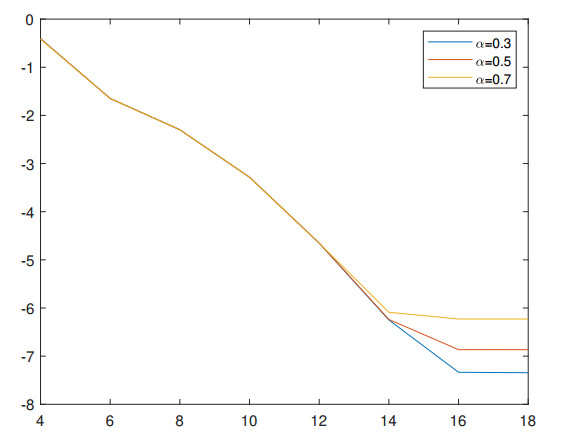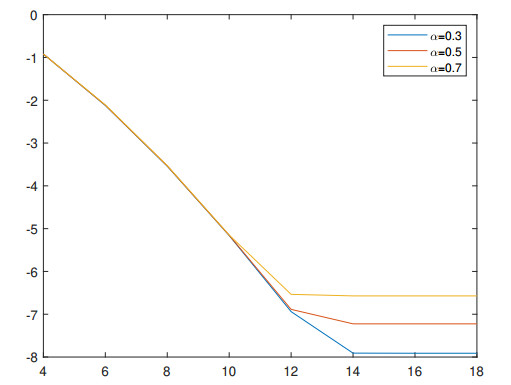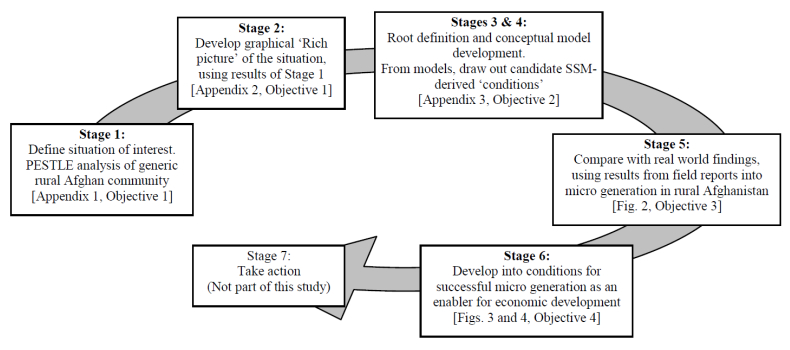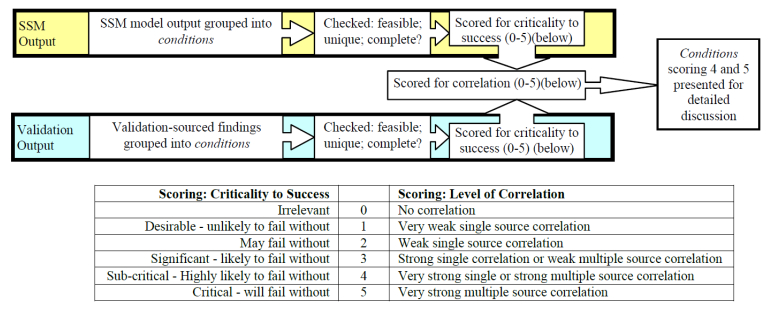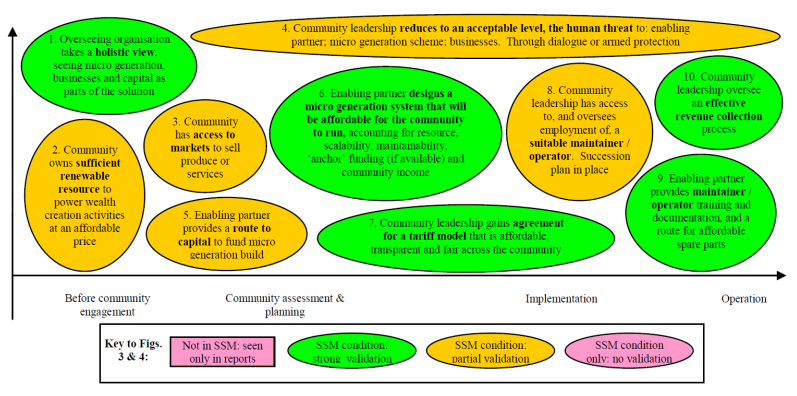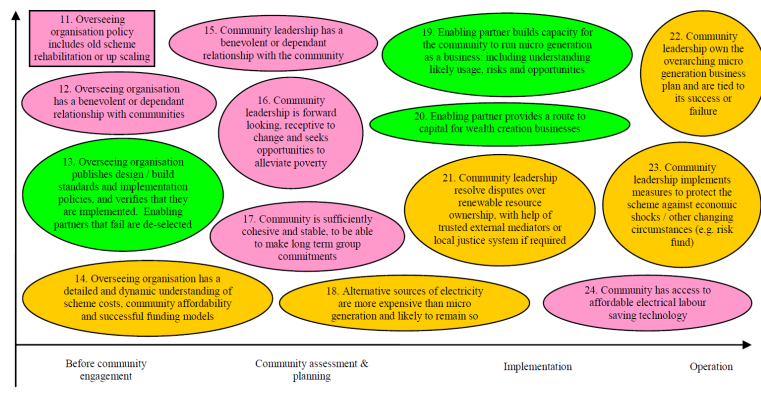Access to reliable electricity eludes many poor rural Afghan communities despite plentiful renewable resources. Micro-generation seems particularly well suited to Afghanistan’s mountainous, decentralised society but even with substantial investment since 2001 it has not lived up to expectations. Recognising the causes are likely to dwell in the human (rather than technical) domain, this study takes a qualitative, soft systems approach to deriving and validating the necessary conditions that might improve the success rate of micro-generation projects in enabling sustainable economic development. It acknowledges the governance limitations inherent in fragile states and the significance of the community as the most stable element of society, putting the latter at the centre of its thinking. Those conditions identified as critical are summarised as: a holistic approach that sees micro-generation as a component of broader economic development; an environment safe enough for project build and operation, and for the markets necessary for wealth creation; and external support to build community capacity to fund and maintain schemes through-life. These conditions are likely to have relevance for other fragile states; the next step is to develop them in the field before deployment as part of a comprehensive approach to poverty alleviation in Afghanistan and similar states.
1.
Introduction
In the present paper, we consider numerical solution of the time fractional Fokker-Planck equations (TFFPEs):
where Ω∈Rd(d=1,2,3), x=(x1,x2,…,xd), u0(x) is smooth on Ω, p:=(p1,p2,…,pd) with pi:=pi(x,t)(i=1,2,…,d) and q:=q(x,t) are continuous functions. ∂αtu represents the Caputo derivative of order α∈(0,1). When α=1 in Eq (1.1), the corresponding equations are a class of very useful models of statistical physics to describe some practical phenomena. TFFPEs are widely used in statistical physics to describes the probability density function of position and the evolution of the velocity of a particle, see e.g., [1,2,3,4]. The TFFPEs also represent the continuous limit of a continuous time random walk with a Mittag-Leffler residence time density. For a deeper understanding of TFFPEs, we refer the readers to [5,6]. In addition, the regularity of the solutions of the TFFPE (1.1) can be found in [7].
For the past few years, many numerical methods were used to solve the TFFPEs. For example, Deng [8] proposed an efficient predictor-corrector scheme. Vong and Wang [9] constructed a compact finite difference scheme. Mahdy [10] used two different techniques to study the approximate solution of TFFPEs, namely the fractional power series method and the new iterative method. Yang et al. [11] proposed a nonlinear finite volume format to solve the two-dimensional TFFPEs. More details can refer to [12,13,14,15]. Besides, it is difficult that analysing the convergence and stability properties of the numerical schemes for TFFPEs, when convective and diffusion terms exist at the same time. In the study of TFFPEs, the conditions imposed on p and q were somewhat restrictive. For example, for solving the one-dimensional TFFPEs, Deng [16] proved the stability and convergence under the conditions that p1 was a monotonically decreasing function and q≤0. Chen et al. [17] obtained the stability and convergence properties of the method with the conditions that p1 was monotone or a constant and q was a constant.
To solve the time Caputo fractional equations, one of the keys is the treatment of the Caputo derivative, which raised challenges in both theoretical and numerical aspects. Under the initial singularity of the solutions of the equations, many numerical schemes are only proved to be of τα in temporal direction, e.g., convolution quadrature (CQ) BDF method [18], CQ Euler method [19], uniform L1 method et al. [20,21]. Here τ represents the temporal stepsize. Considering the singularity of solutions, different numerical formats were established to obtain high convergence orders, e.g., the Alikhanov scheme (originally proposed in [22]) and the L1 scheme (see e.g., [23]) by employing the graded mesh (i.e., tn=T(n/K)r,n=1,2,…,K, r is mesh parameter). It was proved that the optimal convergence of those methods can be 2 and 2−α iff r≥2/α and r≥(2−α)/α, respectively (see e.g., [24,25,26,27,28,29]). The ¯L1 scheme studied in [30,31,32] was another high-order scheme for Caputo fractional derivative. There were also some fast schemes for Caputo fractional derivative, see [33,34,35,36]. When α was small, the grids at the beginning would become very dense. It may lead to the so-called round-off errors. Recently, taking the small α and the initial singularity into account, Li et al. [37] introduced the transformation s=tα for the time variable, and derived and analyzed the equivalent fractional differential equation. They constructed the TL1 discrete scheme, and obtained that the convergence order of the TL1 scheme is of 2−α. Based on the previous research, Qin et al. [38] studied the nonlinear fractional order problem, and established the discrete fractional order Grönwall inequality. Besides, discontinuous Galerkin methods were also effective to solve the similar problems with weak singular solutions [39,40,41].
Much of the past study of TFFPEs (i.e., in [16,17,42,43]) has been based on many restrictions on q and pi,i=1,2,…,d. This reduces the versatility of the equations. In the paper, we consider the more general TFFPE (1.1), i.e., q and pi,i=1,2,…,d, are variable coefficients, and q is independent of pi. We draw on the treatment of the Caputo derivative in [37], introduce variable substitution, and construct the TL1 Legendre-Galerkin spectral scheme to solve the equivalent s-fractional equation. For time discreteness, we take into account the initial singularity, and obtain that the optimal convergence order is 2−α. In terms of spatial discreteness, unlike other schemes [16,17], which impose restrictions on coefficients, the Legendre-Galerkin spectral scheme does not require pi and q to be constants or to be monotonic. Besides, we obtain the following theoretical results. The order of convergence in L2-norm of the method is exponential order convergent in spatial direction and (2−α)-th order convergent in the temporal direction. And the scheme is valid for equations with small parameter α.
The structure of the paper is as follows. In Section 2, we propose the TL1 Legendre-Galerkin spectral scheme for solving TFFPEs. In Section 3, the detailed proof of our main results is presented. In Section 4, two numerical examples are given to verify our obtained theoretical results. Some conclusion remarks are shown in Section 5.
2.
Numerical scheme
We denote Wm,p(Ω) and ||⋅||Wm,p(Ω) as the Sobolev space of any functions defined on Ω and the corresponding Sobolev norm, respectively, where m≥0 and 1≤p≤∞. Especially, denote L2(Ω):=W0,2(Ω) and Hm(Ω):=Wm,2(Ω). Define C∞0(Ω) as the space of infinitely differentiable functions which are nonzero only on a compact subset of Ω and H10(Ω) as the completion of C∞0(Ω). For convenience, denote ||⋅||0:=||⋅||L2(Ω), ||⋅||m:=||⋅||Hm(Ω).
For simplicity, we suppose that Ω=(−1,1)d, and u(x,t)∈H10(Ω)∩Hm(Ω) for 0≤t≤T. First of all, we introduce TL1 scheme to discrete the Caputo fractional derivative. Introducing the change of variable as follows [21,37,44]:
By this, then the Caputo derivative of u(x,t) becomes
Hence, Eq (1.1) can be rewritten as
where ˜p=(˜p1,˜p2,…,˜pd), ˜pd:=pd(x,s1/α),˜q:=q(x,s1/α), and ˜f(x,s)=f(x,s1/α). Let sn=Tαn/K,n=0,1,…,K, and the uniform mesh on [0,Tα] with τs=sn−sn−1. For convenience, Ki, i≥1 represent the positive constants independent of τs and N, where N represents polynomial degree. In addition, we define the following notations
Applying the TL1 approximation, we have
Here the coefficients an,n−l=1τsΓ(1−α)∫slsl−1dr(s1/αn−r1/α)α, and Qn represents the truncation error. For more details, we refer to [37,38]. By Eq (2.6), then Eq (2.3) arrives at
For spatial discretization, we introduce the following basis functions:
where k=(k1,k2,…,kd), IN={0,1,2,…,N−2}. For ψki(xi),i=1,2,…,d, one has
where {Lj(x)}Nj=0 are the Legendre orthogonal polynomials, given by the following recurrence relationship [45]:
Define the finite-dimensional approximation space
where N=(N,N,…,N⏟d). For any function wN(x), write
By Eqs (2.7) and (2.8), we have
Then, the TL1 Legendre-Galerkin spectral scheme is to seek Wn∈XN, such that
Here W0=πNw0, and πN is the Ritz projection operator given in Lemma 2. For instance, if d=1, we solve Eqs (2.3) and (2.4) by
where ˆwn=(ˆwn0,ˆwn1,ˆwn2,…,ˆwnN−2)T, A1j,h=(ψh(x),ψj(x)), j,h∈IN, A2j,h=(ψ′h(x),ψ′j(x)), A3nj,h=(˜pnψ′h(x),ψj(x)), A4nj,h=(˜qnψh(x),ψj(x)), and Fnj,1=(˜fn,ψj(x)).
The typical solution of Eq (1.1) meets [18,46,47]
then, with the help of the changes of variable (2.1), one has (see e.g., [38])
where C>0 is a constant independent of s and x. From [37, Lemma 2.2] and [38, Lemma 2.1], the solution becomes smoother at the beginning.
Now, the convergence results of TL1 Legendre-Galerkin spectral scheme (2.9) is given as follows.
Theorem 1. Assume that ˜q and ~pi,i=1,2,…,d, in (2.3) are bounded, and that the unique solution w of Eqs (2.3) and (2.4) satisfying Eq (2.11) and w(x,s)∈H10(Ω)∩Hm(Ω). Then, there exist N0>0 and τ0>0 such that when N≥N0 and τs≤τ0, Eq (2.9) has a unique solution Wn(n=0,1,…,K), which satisfies
where K∗>0 is a constant independent of τs and N.
3.
Proof of the main results
3.1. Preliminaries
We will present the detailed proof of Theorem 1 in this section. For this, we first introduce the following several lemmas.
Lemma 1. [37,38] For n≥1, we get
Lemma 2. If we given the Ritz projection operator πN:H10(Ω)→XN by
then, one can get that [48]
with d≤m≤N+1, where CΩ>0 is a constant independent of N.
Lemma 3. [49] For any sK=Tα>0 and given nonnegative sequence {λi}K−1i=0, assume that there exists a constant λ∗>0 independent of τs such that λ∗≥∑K−1i=0λi. Assume also that the grid function {wn|n≥0} satisfies
where {Qn|n≥1} is well defined in Eq (2.6). Then, there exists a constant τ∗s>0 such that, when τs≤τ∗s,
where C∗1 is a constant and Eα(x)=∑∞k=0xkΓ(1+kα).
3.2. Proof of Theorem 1
We will offer the proof of Theorem 1 in this section. The projection πNwn of the exact solution wn satisfies
Here Rn=Dατ(wn−πNwn)−Δ(wn−πNwn)+˜pn⋅∇(wn−πNwn)+˜qn(wn−πNwn), and Qn is the truncation error for approximating the fractional derivative defined in Eq (2.6).
The error between numerical solution Wn and exact solution wn can be divided into
Let
Subtracting Eq (2.9) from Eq (3.2), we get that
Setting v=en in Eq (3.4), we obtain
By Lemma 1, we have
By Cauchy-Schwartz inequality, one can obtain that
Here K1=max0≤n≤K{||˜p(x,sn)||0}, and K2=max0≤n≤K{maxx∈Ω|˜q(x,sn)|}. Similarly, we see that
Noting that en∈XN and by Lemma 2, one has
Then
Here K3=max0≤n≤K{CΩ||Dατwn||m,K1CΩ||wn||m,K2CΩ||wn||m}, and Lemma 2 is applied. Substituting Eqs (3.6)–(3.9) into Eq (3.5), one gets
Noting that e0=0 and by Lemma 3, it follows that
By Eq (3.3), we observe
where K∗=max0≤n≤K{CΩ||wn||m,4K3C∗1Eα(4(K21/4+K2)sn)}. This completes the proof.
4.
Numerical results
In this section, two numerical examples are given to verify our theoretical results. We define the maximal L2 error and the convergence order in time, respectively, as
Example 1. Consider the one-dimensional TFFPEs:
where the initial-boundary conditions and the forcing term function f are choosen by the analytical solution
In this case, q is independent of p1, furthermore, p1 and q are not monotone functions.
We solve this problem with the TL1 Legendre-Galerkin spectral method. Table 1 gives the maximal L2 errors, the convergence orders in time and the CPU times with N=14. The temporal convergence orders are close to 2−α in Table 1. For the spatial convergence test, we set K=8192. In Figure 1, we give the errors as a function of N with α=0.3,0.5,0.7 in logarithmic scale. We can observe that the errors indicate an exponential decay.
Example 2. Consider the two-dimensional TFFPEs:
where the initial-boundary conditions and the forcing term function f are choosen by the analytical solution
Table 2 gives the maximal L2 errors, the convergence orders in time and the CPU times with N=14. The temporal convergence orders are close to 2−α in Table 2. For the spatial convergence test, we give the errors as a function of N for α=0.3,0.5,0.7 and K=8192 in Figure 2. We use the logarithmic scale for the error-axis. Again, we observe that the errors indicate an exponential decay.
5.
Conclusions
We present a TL1 Legendre-Galerkin spectral method to solve TFFPEs in this paper. The new scheme is convergent with O(τ2−αs+N1−m), where τs, N and m are the time step size, the polynomial degree and the regularity of the analytical solution, respectively. In addition, this TL1 Legendre-Galerkin spectral method still holds for problems with small α and gives better numerical solutions near the initial time. The new scheme can achieve a better convergence result on a relatively sparse grid point.
Acknowledgments
The work of Yongtao Zhou is partially supported by the NSFC (12101037) and the China Postdoctoral Science Foundation (2021M690322).
Conflict of interest
The authors declare that they have no conflicts of interest.









 DownLoad:
DownLoad:
